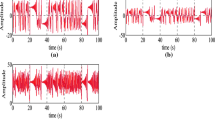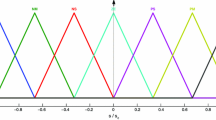Abstract
In this paper, the synchronization problem of two different fractional-order chaotic systems has been investigated. Variable fractional orders are considered in this problem. An optimal synchronization strategy is defined for the fractional case. The optimality conditions are obtained using the fuzzy modeling of fractional-order systems. These models are with the type-1 and type-2 Takagi–Sugeno structures. Also, using chaotic masking, the synchronization method is applied for secure communication. Finally, using the simulation examples, the performance of the proposed method is shown.







Similar content being viewed by others
References
Antão R, Mota A, Martins RE (2018) Model-based control using interval type-2 fuzzy logic systems. Soft Comput 22(2):607–20
Arman KB, Fallahi K, Pariz N, Leung H (2009) A chaotic secure communication scheme using fractional chaotic systems based on an extended fractional Kalman filter. Commun Nonlinear Sci Numer Simul 14:863–879
Behinfaraz R, Ghaemi S, Khanmohammadi S (2019) Risk assessment in control of fractional-order coronary artery system in the presence of external disturbance with different proposed controllers. Appl Soft Comput 77(290–9):11
Behinfaraz R, Ghaemi S, Khanmohammadi S, Badamchizadeh MA (2020) Fuzzy-based impulsive synchronization of different complex networks with switching topology and time-varying dynamic. Int J Fuzzy Syst 21:1–2
Behinfaraz R, Badamchizadeh MA (2015) New approach to synchronization of two different fractional-order chaotic systems. In: 2015 the international symposium on artificial intelligence and signal processing (AISP), pp 149–153. IEEE
Behinfaraz R, Badamchizadeh MA (2015) Synchronization of different fractional-ordered chaotic systems using optimized active control. In: 2015 6th international conference on modeling, simulation, and applied optimization (ICMSAO), pp 1–6. IEEE
Behinfaraz R, Ghaemi S, Khanmohammadi S (2019) Risk analysis in synchronization of economical system with fractional order modeling. 20:18. A 387, Montreal, Canada, 37383746
Behinfaraz R, Ghaemi S, Khanmohammadi S, Ali Badamchizadeh M (2020) Secure Communication using the synchronization of time-varying complex networks by fuzzy impulsive method. In: 2019 IEEE east-west design and test symposium (EWDTS) 2019 Sep 13, pp 1–4. IEEE
Behinfaraz R, Ghaemi S, Khanmohammadi S, Badamchizadeh MA (2020) Time-varying parameters identification and synchronization of switching complex networks using the adaptive fuzzy-impulsive control with an application to secure communication. Asian J Control
Castillo O, Melin P, Alanis A, Montiel O, Sepúlveda R (2011) Optimization of interval type-2 fuzzy logic controllers using evolutionary algorithms. Soft Comput 15(6):1145–60
Duncan TE, Hu Y, Pasik-Duncan B (2000) Stochastic calculus for fractional Brownian motion. I Theory SIAM J Control Optim 38:582–612
El-Gohary A (2006) Optimal synchronization of Rössler system with complete uncertain parameters. Chaos, Solitons and Fractals 27(2):345–355 (ISSN 0960-0779)
Foroogh M, Jahed MMR, Rahmani CZ (2012) Synchronization of different-order chaotic systems: adaptive active vs. optimal control. Communications in Nonlinear Science and Numerical Simulation 17(9):3643–3657 (ISSN 1007-5704)
Gil P, Oliveira T, Palma LB (2019) Online non-affine nonlinear system identification based on state-space neuro-fuzzy models. Soft Comput 23(16):7425–38
Guerra RM, Yu W (2008) Chaotic synchronization and secure communication via slidingmode observer. Intern J Bifurc Chaos 18:235–243
Hashemi S, Pourmina MA, Mobayen S, Alagheband MR (2020) Design of a secure communication system between base transmitter station and mobile equipment based on finite-time chaos synchronisation. Int J Syst Sci 51(11):1969–86
Hu Y, Øksendal B (2003) Fractional white noise calculus and applications to finance. Infin Dim Anal Quant Probab Relat Top 6:1–32
Jian-Bing H, Guo-** L, Shi-Bing Z, Ling-Dong Z (2015) Lyapunov stability theorem about fractional system without and with delay. Commun Nonlinear Sci Numer Simul 20:905–913
Jiang N, Zhao A, Liu S, Zhang Y, Peng J, Qiu K (2020) Injection-locking chaos synchronization and communication in closed-loop semiconductor lasers subject to phase-conjugate feedback. Opt Express 28(7):9477–86
Manabe S (2003) Early development of fractional order control, DETC2003/VIB-48370. In: Proceedings of DETC’03, ASME 2003 design engineering technical conference, Chicago, Illinois, September 2–6
Momani S, Odibat Z (2007) Numerical comparison of methods for solving linear differential equations of fractional order. Chaos Soliton Fract 31(5):124855
Odibat ZM, Momani S (2006) Application of variational iteration method to nonlinear differential equations of fractional order. Int J Nonlinear Sci Numer Simul 7(1):2734
Pecora LM, Carroll TL (1990) Synchronization in chaotic systems. Phys Rev Lett 64:821824
Samimi M, Majidi MH, Khorashadizadeh S (2020) Secure communication based on chaos synchronization using brain emotional learning. AEU Int J Electron Commun 127:153424
Soltani M, Telmoudi AJ, Chaouech L, Ali M, Chaari A (2019) Design of a robust interval-valued type-2 fuzzy c-regression model for a nonlinear system with noise and outliers. Soft Comput 23(15):6125–34
Tao CW (2004) Robust control of systems with fuzzy representation of uncertainties. Soft Comput 8(3):163–72
Tavazoei MS, Haeri M (2007) A necessary condition for double scroll attractor existence in fractional-order systems. Phys Lett A 367:102113
Wang R, Zhang Y, Chen Y, Chen X, ** L (2020) Fuzzy neural network-based chaos synchronization for a class of fractional-order chaotic systems: an adaptive sliding mode control approach. Nonlinear Dyn 21:1–3
Author information
Authors and Affiliations
Corresponding author
Ethics declarations
Conflict of interest
The authors declare that they have no conflict of interest.
Ethical approval
This study does not contain any studies with human participants or animals performed by any of the authors.
Informed consent
Informed consent was obtained from all individual participants included in the study.
Additional information
Publisher's Note
Springer Nature remains neutral with regard to jurisdictional claims in published maps and institutional affiliations.
Rights and permissions
About this article
Cite this article
Soleimanizadeh, A., Nekoui, M.A. Optimal type-2 fuzzy synchronization of two different fractional-order chaotic systems with variable orders with an application to secure communication. Soft Comput 25, 6415–6426 (2021). https://doi.org/10.1007/s00500-021-05636-1
Accepted:
Published:
Issue Date:
DOI: https://doi.org/10.1007/s00500-021-05636-1




